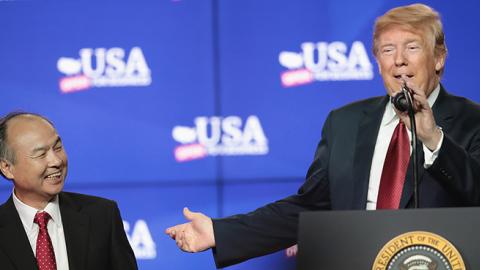Foxconn "announced in late January":https://www.nytimes.com/2019/01/30/business/foxconn-factory-wisconsin.h… that it was backing down from its game-changing plans to build a huge liquid crystal display (LCD) fabrication plant in Wisconsin. The deal was first reported in 2017 and President Trump was part of the groundbreaking ceremony in mid-2018. The initial plans were to have over 13,000 mostly production workers at the facility to make display screens for television and cell phones. Foxconn, which based in Taiwan, "quickly began lowering expectations":https://www.jsonline.com/story/money/business/2019/01/30/foxconn-recons… for the manufacturing component of the project. The company now intends to make its facility in Racine County an “innovation hub” and devote only 10-20 percent of its workforce to making LCDs for cell phones. Since the Foxconn investment was the poster-child of President Trump’s project to rejuvenate manufacturing jobs in the United States, it is important to understand the radical change in plans. There may be mundane economic factors explaining the decision, but one possible result is that it may affect in important ways the seemingly unrelated "now taking place":https://www.reuters.com/article/us-usa-trade-china/trump-upbeat-on-chin… between Washington and Beijing.
The Trump administration is serious about restoring production jobs to the United States, and his margin of victory in the 2016 election depended to a large degree on the votes of industrial workers and others related to the factory economies in the Upper Midwest and Central Atlantic regions. The administration has had some early success since taking office. Almost half a million new jobs have been created in manufacturing since January 2017, industrial production has steadily grown, and capital investment is also expanding in the sector. Trump trade policy clearly favors the return of factories to the United States. The new "North American trade agreement":https://ustr.gov/about-us/policy-offices/press-office/fact-sheets/2018/… has, for example, a sizable boost in the amount of local content required for preferences in the auto sector. It also limits the ability of U.S. firms operating in Mexico and Canada to use neutral arbitration to settle disputes between companies and governments, making investments there somewhat riskier. Foxconn’s Wisconsin plant was an important symbol that the technology sector might return production to domestic plants. The state of Wisconsin, one of the most heavily industrialized states in the country, provided "unusually generous incentives":https://www.marketwatch.com/story/wisconsin-taxpayers-need-to-pull-the-…, amounting to over $200,000 per new job created, to the Taiwanese firm to win the competition for the LCD plant.
There are cyclical and possible political problems that have affected Foxconn’s thinking. Its spokesman said that: “In terms of TV, we have no place in the U.S.” But he went on to say that there is a place in China and Japan (which still maintains some production of televisions and other smaller electronic devices, but whose labor costs are not far behind those in the U.S.) for an LCD plant. It was also never clear "if enough skilled workers could be found":https://www.forbes.com/sites/andreahill/2019/01/30/how-much-does-foxcon… in Wisconsin to meet the needs of a sophisticated technology operation. A change in the governor’s office in Wisconsin put into place "a democrat who was deeply critical of":https://www.washingtonpost.com/news/wonk/wp/2017/08/09/the-foxconn-deal… of the incentive package given by his predecessor to Foxconn. But the new governor has not reneged on the package. The major change in the economics of this business is that sales of smart phones have declined in the last year. Apple reported 15 percent decline in iPhone sales the last year.
These recent developments are only marginally important for a $10 billion capital investment which was years in the planning stage. Why Foxconn did not know there was a problem with labor costs and availability in the United States or that the smart phone cycle is cyclical is something of a mystery and hardly seems sufficient to change a huge investment decision. Critics note that Foxconn has a history of "reneging on investment announcements":https://www.marketwatch.com/story/foxconns-history-of-broken-promises-c…, citing a 2013 deal announced in Pennsylvania that was touted to create 500 jobs, and which never materialized.
Foxconn has also been an exemplar in American opinion of outsourcing production to China, where it employs hundreds of thousands of production workers assembling electronics for Apple and others. While owned and directed by management in Taiwan, the company and its supply chain are deeply integrated in China. President Trump invested a good deal of political capital in promising to reverse outsourcing. Foxconn’s rollback of the production side of the LCD plant is hence a problem for him.
China has offered to help "reduce the trade deficit":https://finance.yahoo.com/news/bye-bye-trade-war-china-160627486.html with the U.S. in part by buying more U.S.-made products, especially grains, liquified natural gas, commercial jets and medical products. But its history of following through on such promises in the past is not a strong one. The Reagan motto used to great effect in the cold war arms-control negotiations, “Trust but verify” is now "animating the U.S. strategy":https://finance.yahoo.com/news/china-says-trade-talks-u-080443945.html in the crucial negotiations with China which must be completed by March 2 to avoid another escalation of U.S. tariffs on Chinese products. One can argue that having an innovation center in Wisconsin with some 10,000 researchers is a valuable asset, but when will this become a reality? Foxconn is not a Chinese company, but its fate and operating methods are tied strongly to the Middle Kingdom. Its climb down on a high profile and politically-sensitive manufacturing plant for the Upper Midwest is thus likely one more piece of evidence to harden the stance of U.S. negotiators and insist on more than promises from China to buy its way toward reducing the huge trade gap in trade with the United States. President Trump will be closely watching both the Foxconn case and the trade negotiations with China, having linked his political fate to both.



















